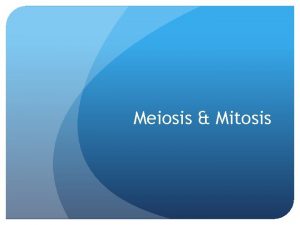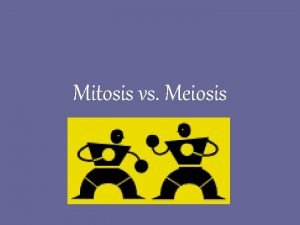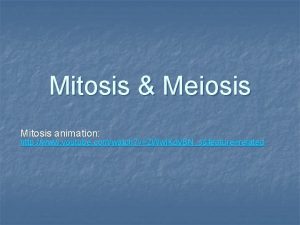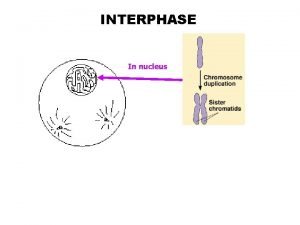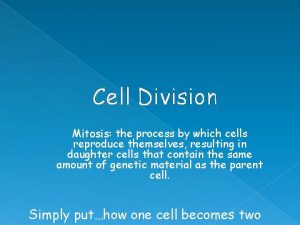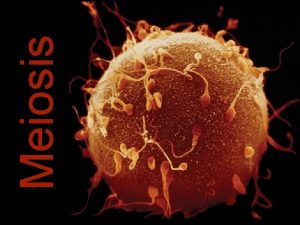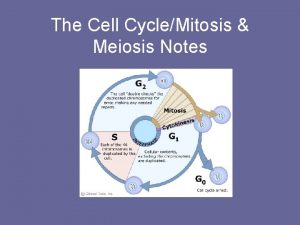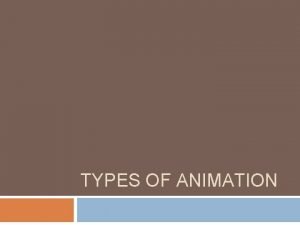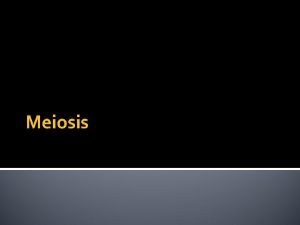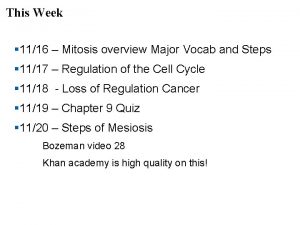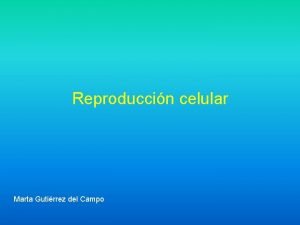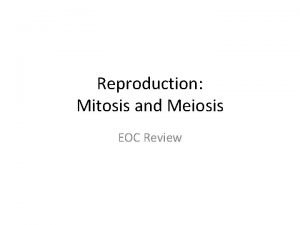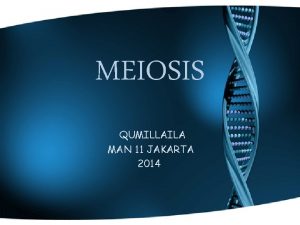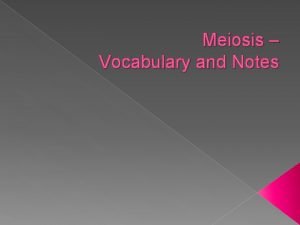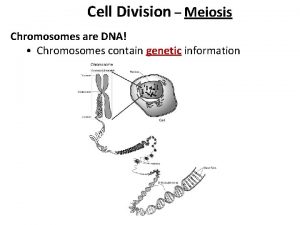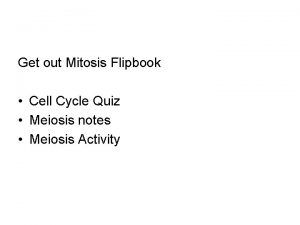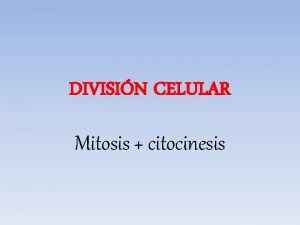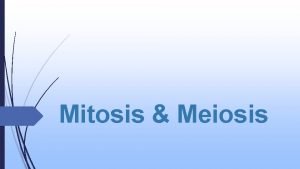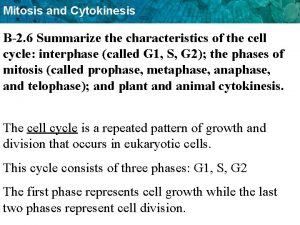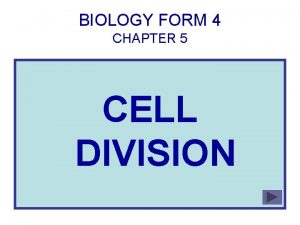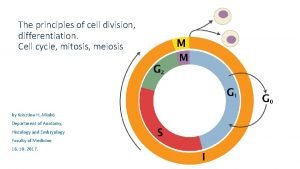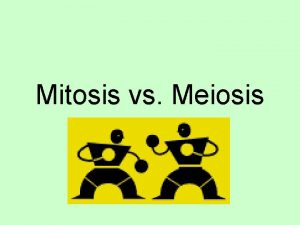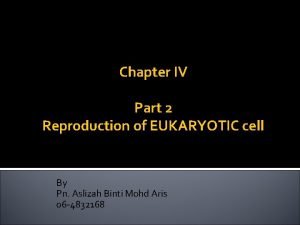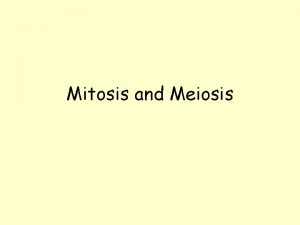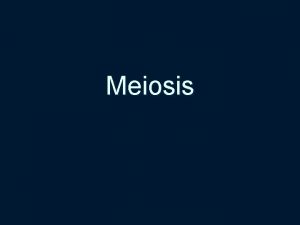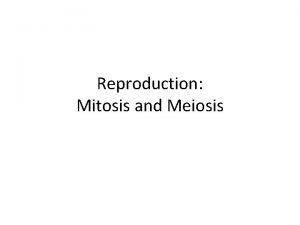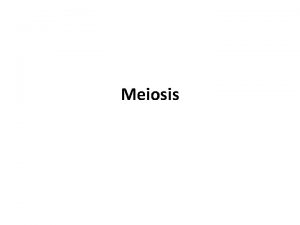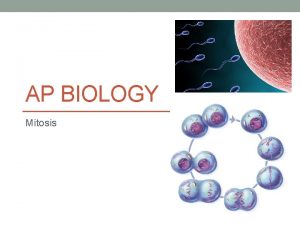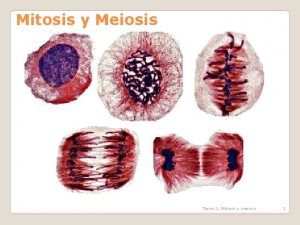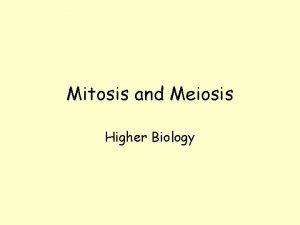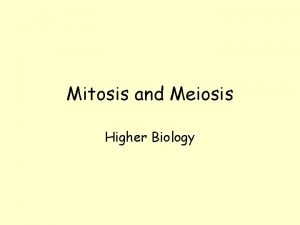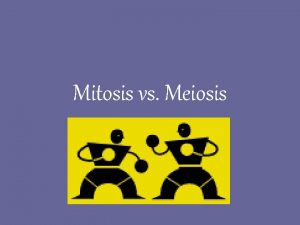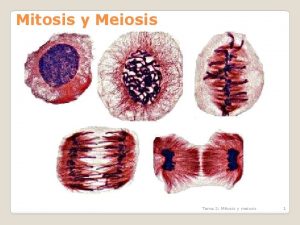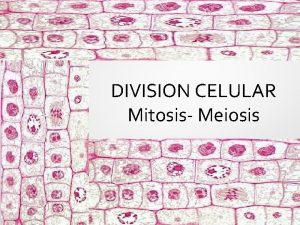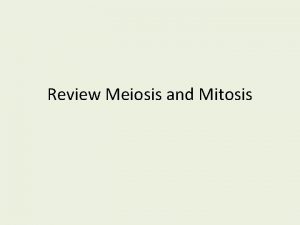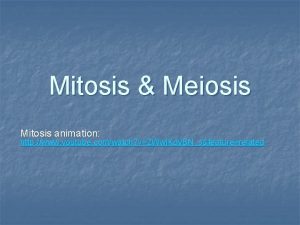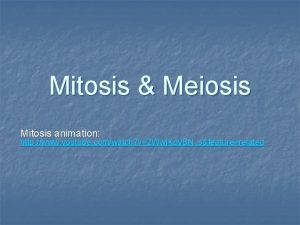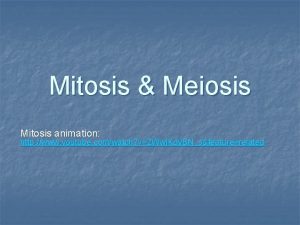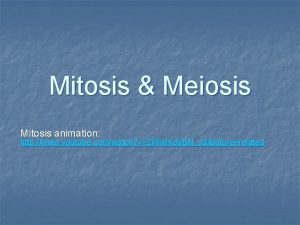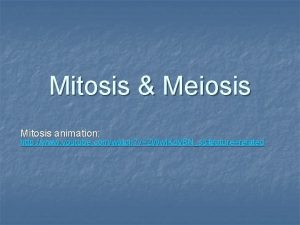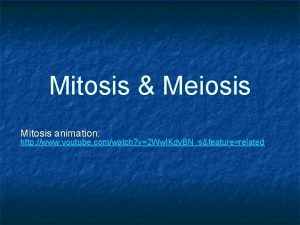Meiosis vs Mitosis Animation 2 divisions daughter cells



























- Slides: 27


Meiosis vs. Mitosis Animation ▫ ▫ ▫ 2 divisions ▫ daughter cells ▫ genetically ▫ division different from parent ▫ Begins with produce interphase 4 cells ▫ PMAT 2 n 1 n ▫ produces gametes ▫ ▫ crossing over!! 1 division daughter cells genetically identical to parent ▫ produces 2 cells ▫ 2 n produce cells for growth & repair NO crossing over


Meiosis Stages of Meiosis Review Bio. Flix Animation Unique Features of Meiosis

Crossing Over • Homologous Chromosomes • Synapsis • Chiasma form • Cross over at matching regions of nonsister chromatids • genetic recombination increases variation!!! • Process itself varies • Bacteria – asexual reproduction

Putting it all together… meiosis fertilization mitosis + development gametes 46 23 meiosis 23 egg 23 46 23 zygote fertilization sperm 46 46 4646 46 mitosis development

An Intro to Animal Development • Fundamental biological question: How does a single cell—the fertilized egg—develop into a multicellular individual? • Development proceeds in ordered phases through organism’s life cycle: ▫ ▫ ▫ Gametogenesis Fertilization Cleavage Gastrulation Organogenesis


Gametogenesis – sperm & egg production

Oogenesis germinal cell (diploid) primary follicles fallopian tube fertilization primary oocyte (diploid) MEIOSIS I secondary oocyte (haploid) first polar body MEIOSIS II developing follicle mature follicle with secondary oocyte ruptured follicle (ovulation) after fertilization second polar body ovum (haploid) corpus luteum

Egg Structure and Function • Relatively large & nonmotile • Size largely due to nutrient storage, required for early embryonic development • Quantity of nutrients varies across species ▫ Relatively small mammalian egg supplies nutrients for early development ONLY embryos start to obtain nutrition through placenta shortly after fertilization ▫ Egg-laying species form larger eggs yolk of the egg is embryo’s SOLE nutritional source prior to hatching

Spermatogenesis Epididymis Testis Coiled seminiferous tubules germ cell (diploid) primary spermatocyte (diploid) MEIOSIS I secondary spermatocytes (haploid) Vas deferens spermatids (haploid) spermatozoa ▫ continuous & prolific process ▫ 100 -600 million sperm can be produced daily MEIOSIS II

• Fertilization - haploid sperm and egg cells fuse to form diploid zygote (a fertilized egg). • Certain conditions MUST be met before a zygote can form: ▫ ▫ Location: gametes in same place at same time. Recognition: recognize & bind to each other. Fusion! Trigger onset of development.

Successful fertilization leads to development – how do we become a person from 2 single cells? Do you think the process is the same for all living things? Explain and describe your vision of this process.

Why Does Only One Sperm Enter the Egg? • Animals use different mechanisms to avoid polyspermy fertilization by more than one sperm • Ex: sea urchins - fertilization stimulates creation of a physical barrier ▫ Ca 2+-based signal is rapidly induced & propagated throughout the egg, form a fertilization envelope keeps away additional sperm • Ex: mammals - cortical granules release enzymes modify egg cell receptors prevent binding by additional sperm.

Cleavage • Cleavage - set of rapid cell divisions in animal zygotes immediately after fertilization. ▫ 1 st step is embryogenesis - process that makes single-celled zygote into multicellular embryo. ▫ partitions egg cytoplasm without additional growth of the zygote. ▫ Cells created by cleavage divisions called blastomeres. ▫ Completed cleavage results in embryo consisting of mass of blastomere cells called a blastula.


Gastrulation • Gastrulation - extensive & highly organized cell movements radically rearrange embryonic cells into structure called the gastrula. ▫ results in formation of embryonic tissue layers (**tissue is integrated set of cells functioning as a unit) ▫ most embryos have 3 primary tissue layers: ectoderm, mesoderm, and endoderm. �these tissues are called germ layers because they give rise to adult tissues and organs.

• Ectoderm - forms outer covering of adult body & nervous system • Mesoderm - gives rise to muscle, most internal organs, & connective tissues like bone & cartilage • Endoderm - produces lining of digestive tract or gut, along with some associated organs


What if something goes wrong? What happens then? ? ?

• nondisjunction - chromosomes do not segregate correctly during meiosis • Incorrect chromosome # • • Deletion Duplication Inversion Translocation ** Extra chromosomes often means survival** **Missing chromosomes often

• Monosomy - One less chromosome due to missing chromosome in gamete Ex: Turner Syndrome K A R Y O T Y P E

• Trisomy - Gamete has an extra chromosome • Ex: Trisomy 21 (Down Syndrome)

• Polyploidy - Complete EXTRA sets of chromosomes – almost ALWAYS lethal to animals – plants can be healthier & larger

Genetic testing • Amniocentesis in 2 nd trimester ▫ sample of embryo cells ▫ stain & photograph chromosomes • Analysis of karyotype

Sex chromosomes abnormalities • Human development more tolerant of wrong numbers in sex chromosomes Results in variety of distinct syndromes ▫ ▫ XXY = Klinefelter’s syndrome male XXX = Trisomy X female XYY = Jacob’s syndrome male XO = Turner syndrome female
 Meiosis
Meiosis Mitosis and meiosis
Mitosis and meiosis Mitosis and meiosis animation
Mitosis and meiosis animation Mitosis and meiosis youtube
Mitosis and meiosis youtube Number of divisions in mitosis
Number of divisions in mitosis Number of divisions in mitosis
Number of divisions in mitosis How many divisions take place during meiosis? *
How many divisions take place during meiosis? * Meiosis 1 and 2 diagram
Meiosis 1 and 2 diagram Anaphase
Anaphase When does crossing over occur in meiosis
When does crossing over occur in meiosis Traditional animation vs computer animation
Traditional animation vs computer animation How is meiosis different in males and females
How is meiosis different in males and females Painting
Painting Anafase
Anafase Comparison of mitosis and meiosis table
Comparison of mitosis and meiosis table Faktor pembanding mitosis dan meiosis
Faktor pembanding mitosis dan meiosis Meiosis vocabulary
Meiosis vocabulary Crossing over meiosis
Crossing over meiosis Venn diagram of mitosis and meiosis
Venn diagram of mitosis and meiosis Ciclo celular
Ciclo celular Compare mitosis and meiosis using venn diagram
Compare mitosis and meiosis using venn diagram Summarize mitosis
Summarize mitosis Mind map mitosis meiosis
Mind map mitosis meiosis Oogenesis diagram
Oogenesis diagram Mitosis vs meiosis double bubble compare and contrast
Mitosis vs meiosis double bubble compare and contrast Chromosome/mitosis/meiosis review answer key
Chromosome/mitosis/meiosis review answer key Differences between mitosis and meiosis
Differences between mitosis and meiosis Chromosome sets (=n) in mitosis and meiosis
Chromosome sets (=n) in mitosis and meiosis
